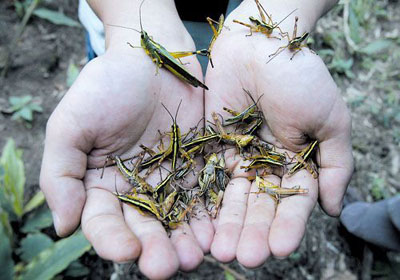Global warming could reduce the locust population in China, according to a study published by last week's Proceedings of the National Academy of Sciences.
Researchers analyzed a 1,000-year record of locust plagues in China between AD 957 and 1956 and found a correlation between population size and decadal mean temperature. They found locust population grew larger during cold periods than during warm periods.
File photo: About 2,000 mu (133.4 hectares) of farmlands in the Jinyun Mountain, southwest China's Chongqing Municipality, were plagued by locusts in early August this year.
China's locust plagues have historically come from marshlands among the tributaries of the lower reaches of the Yellow and Yangtze river systems.
"The cold periods are generally accompanied by higher frequencies of draughts or floods. In a draught or after a flood, the size of habitats conducive to locusts' proliferation would increase as the water receded," says Zhang Zhibin, co-uthor of the research paper and director of Institute of Zoology of the Chinese Academy.
However, previous research showed that a single warm year could assist locust larvae's survival through cold winters and enable larger swarms to form in the coming year. Zhang believes there's an explanation for this paradox.
He points out that locusts' ecological response to temperature changes could be completely different, depending on the length of the cycles researchers analyze.
During a longer period - such that of a decade - the favorable effects warm temperatures have on locust larvae growth could compensate for its adverse effects on locusts' habitat expansion.
"The research into the relationships between climate change and locust plagues throughout history are very important for people to understand the patterns of locust population growth and to help us develop relevant strategies to curb its growth," says Zhang De'er, chief scientist of National Climate Center of China Meteorological Administration.
Since the 1950s, the government had adopted intensive management measures to reduce the size of locusts' breeding habitats and has monitored and recorded the incidence of locust plagues for several decades. However, locusts have again become a serious problem in North China in recent years.
According to Zhang De'er, locust plagues follow a cycle, which is actually affected by such multiple factors as temperature, changes in precipitation and geological shifting.
All About Climate Change Locusts
(China Daily, China.org.cn.cn September 24, 2007)






